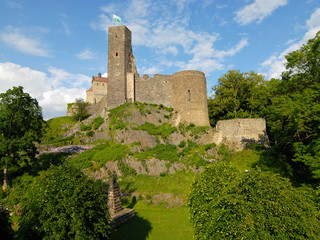Behind a strong man is a strong woman – this has always been the case. On our September route we want to take you into the world of wives and mistresses of Saxon kings. Come with us and find out more about strong women of past centuries.
Countess Cosel is by far the most famous successful woman from Saxony. Therefore we have devoted to her a route of her own: Countess Cosel – the Mistress of the King
Delitzsch Baroque Castle (A)
Henriette Charlotte von Nassau-Idstein (1693 - 1734)
Duchess Henriette Charlotte von Sachsen-Merseburg conceived a child here, but with her lover and not with her husband Duke Moritz Wilhelm. In those times, that was the most disgusting thing a woman could do. European nobility would have had few scruples in removing the illegitimate child from Duchess Henriette Charlotte after its birth and giving it to poor people to bring up under another name. But the child died shortly after an emergency baptism. This tragic outcome was good news for Augustus the Strong. The rival line of Sachsen-Merseburg died out with this sorrowful noble couple.
Henriette Charlotte started to direct the interior decoration and brought her private treasure collection and jewellery with her. The prestigious doors, the printed linen wallpapers and the fireplace in the ducal private quarters date from this time. Interesting details about the life of the widow duchess and the everyday life of the servants in the lady’s palace in Delitzsch can be learned from the exhibition in Delitzsch Baroque Castle.
Details about Delitzsch Castle
Further to station B – Rochlitz Castle, circa 76 km
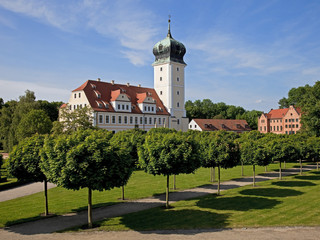
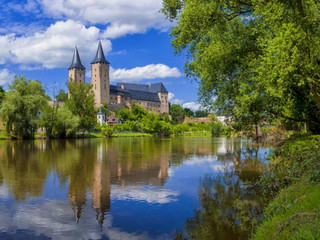
Rochlitz Castle (B)
Elisabeth von Rochlitz (1502 - 1557)
Elisabeth von Rochlitz is regarded as one of the most influential princesses of the Reformation period. The daughter of a Hessian landgrave came to Saxony in 1517 as daughter-in-law of the great opponent of Luther, Duke George the Bearded. At the Dresden court the fun-loving young woman made enemies, especially after 1526, when she turned to the teachings of Luther. After her husband John suddenly died in 1537, the childless princess kept her inheritance, the offices of Rochlitz and Kriebstein, by intrigue. Against the will of Duke George, Elisabeth introduced the Reformation there immediately. Elisabeth left Rochlitz Castle in 1547 after 10 years, when Rochlitz got caught up in the chaos of the Schmalkaldic War. Elisabeth was never to enter it again before her death in 1557. Guided tours »A Guest of Elisabeth von Rochlitz« can be booked in advance. From April 27 2013 there will be an exhibition about the history of the castle and the long forgotten Wettin rulers who lived here: »Fat. One-Eyed. Revolutionary. - Three Wettins for a thousand stories«. From May 1 to 31 October 2014 an exhibition about Elisabeth von Rochlitz and the women of the Reformation »a history of STRONG WOMEN - 500 years of Reformation« will be shown.
Further to station C – Albrechtsburg Castle, Meissen about 66 km
After the division of the country in 1485 and the development of Dresden as the seat of residence for the Wettins, the first grandiose castle in Germany was empty. Only one single person was to reside longer in the Albrechtsburg Meissen: Sidonie of Bohemia.
Sidonie, also known as Zdenka or Zedena, was the daughter of the king of Bohemia. In 1459, at the age of 10, Sidonie was married to Duke Albert.
She refused to follow her husband, Albrecht the Courageous, when he went to war in the Netherlands and lived for almost ten years without her husband and made decisions herself with a small entourage in the Albrechtsburg. Her son George the Bearded ruled in Dresden. 95 of Sidonie’s letters have survived – quite a sensation.
Two letters are on display in the new exhibition »Living in the castle – What it must have been like«, and are explained at the audio station. Today the letters are regarded as unique evidence of everyday and noble life in the 15th century. But on the Albrechtsburg there are also signs of other Wettin ladies. As a counterpart to the Dresden wall mural »Procession of Princes« , there is an entire room decorated with pictures of Wettin princes whose lives are explained on the audio station.
Details about the Albrechtsburg Castle
Further to station D – Weesenstein Castle, about 50 km
Meissen Albrechtsburg Castle (C)
Sidonie of Bohemia (1449 - 1510)
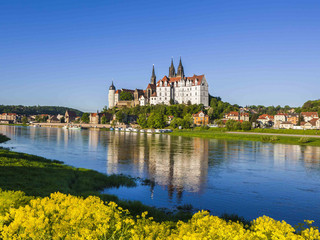
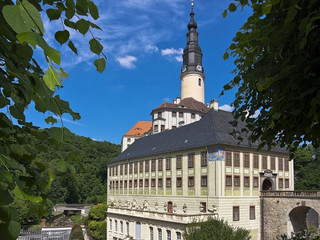
In the 19th century, Queen Amalie Auguste often spent time with her husband, King John I of Saxony, at the idyllic Weesenstein Castle.
During her harmonic and faithful marriage, which lasted more than 50 years, Amalie Auguste bore her husband nine children.
Today the original furnished rooms of the royal couple can be seen at Weesenstein. The castle, which has been standing over the Mueglitz river valley for more than 700 years, was frequently rebuilt, partly demolished and changed to fit the contemporary taste. For that reason Gothic to Classical styles can be found there.
A walk in the castle park, a visit to the restaurant »Koenigliche Schlosskueche« or a tankard of good Weesenstein Castle brew, with a tradition reaching back to the 16th century, all guarantee a relaxing experience.
Details about Weesenstein Castle
Further to station E – Stolpen Castle, about 26 km
Weesenstein Castle (D)
Queen Amalie Auguste (1801 – 1877)
Stolpen Castle (E)
Anna Constantia Countess von Cosel (1680 – 1765)
Already visible from afar, 800-year-old medieval Stolpen Castle towers majestically above the surrounding countryside right between the Saxon and Bohemian Switzerland and Dresden, the Saxon capital. In 1222, Stolpen Castle was first mentioned in records but it was only by its most famous resident, Anna Constantia Countess von Cosel, that the castle eventually achieved true fame. Being the most well-known and influential mistress of Augustus the Strong, Saxon Elector and King of Poland, she fell victim to intrigues at the Saxon court wherefore she was banished to Stolpen Castle. Here, she was held captive behind the basalt walls for almost half a century, until her death in 1765. Almost no one else embodies both myth and truth, legend and reality in quite such a unique manner. Her burial place is located in the Castle Chapel.
